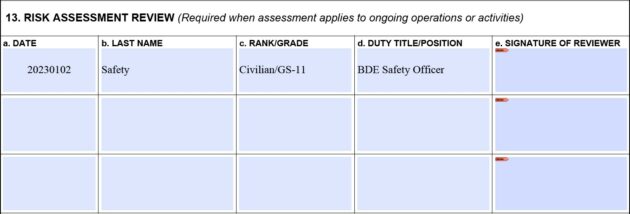Risk is inherent in all military events, trainings, and operations. So, it’s up to leaders to ensure their Soldiers are safe while performing their duties.
I’ll answer a few questions about the US Army Deliberate Risk Assessment Worksheet (DRAW) and then do the walkthrough on building one.
Questions
Where can I get the DRAW? You can find an editable DD Form 2977 Deliberate Risk Assessment Worksheet here. If it comes up with a “Please Wait…” PDF page, download it to your desktop, and open it from your desktop, and you should be ready to go. Armypubs is always an excellent spot to get it, too. Army Safety is also a valuable resource for all things safety in the Army.
When do you need a DRAW? Whenever you do a unit-sponsored event, training, or operation. Even your Unit Organization Day had a DRAW if they did it right.
How long should a DRAW be? Long enough to identify and mitigate all of the risks you assess in your event.
Administration Information
This part is self-explanatory. Fill in the information but don’t sign yet. We’ll come back to that.
Subtask/Substep of Mission/Task
You’ll write a task of the overall mission or training. For example, you can write “Small Arms range operations” if you’re conducting an M4 range. Here’s how it’ll look:

Use your imagination here. There are tons of substeps in a mission or training, so come up with something that is a part of your mission. Here are some other examples of Subtasks/Substeps you could use:
- Environmental Considerations
- Wildlife
- Range operations
- Convoy operations
- Small Arms Range Operations
- Mounted or Dismounted Movement
- Vehicle Operations
- Aircraft Operations
- PMCS of Equipment
- Set up/tear down
- Watercraft Operations
- Swim Training
Hazard
Here, you’ll describe the hazard. But, again, be specific because how you define the threat determines the action you’ll take to reduce risk.
For example, here’s a hazard for our M4 range: Hearing loss from firing an M4.
Ask these two questions: What’s the hazard, and what’s the effect? Don’t just write “hearing loss” because that doesn’t tell the reader the risk a leader needs to mitigate. If you only put “hearing loss,” many things can cause ear injury that may require different actions. Specifically, we’re talking about an M4 range, so putting “hearing loss from firing an M4” describes the risk of firing an M4 and the effect of the hazard.
Hazards may vary depending on the situation, so there are way too many to put in a blog post. However, I’ll put down a few I had for an M4 range:
- Eye injury from deflected brass, fragments, rocks
- Ear injury from firing an M4
- Burns from brass
- Dehydration caused by lack of water consumption
- Overheating caused by lack of water consumption
- Lack of communication causing delays in training
- Wildlife stings and bites causing allergic reactions
- Injury or death caused by inclement weather
- Fratricide due to negligent discharges
- Low visibility causes firers to lose sight of their left and right limits
- Accident during movement causing damage to personnel and property
- Lower extremity injury caused during dismounted operations
- Excessive speed causing a vehicle accident
- Vehicle rollover caused by erratic driving
- Pinches, trips, and falls caused by working around unfamiliar equipment
- Illness caused by improper sanitation
- Injury caused by falling into foxhole positions
Here’s what we have so far:

Also, be range-specific with your hazards. For example, range 55 will be different from Range 56, and so on. So, do a good reconnaissance of your training area and equipment and assess the inherent risks in your training activity.
Initial Risk
This is the risk level you reasonably believe the risk poses to the mission or force if you do nothing to lower the risk factor. So, for instance, if you have “hearing loss from firing an M4” as your risk and if you do nothing to remind people to wear ear protection, then there’s a risk that you’re not attempting to decrease.
Use their matrix if you’re stuck assessing initial risk levels:

Most initial risks for routine training missions are medium to Low. However, events like airborne operations tend to have a higher initial risk, so pay attention to the matrix and assess where your initial risk falls.
A good rule of thumb for assessing risk is if life, limb, eyesight, or Soldier’s long-term well-being is threatened, then the risk is most likely Medium. On the other hand, if the risk does not cause significant long-term damage or injury to personnel or property, low is an excellent place to start. Either way, it’s a risk, and the leaders are responsible for mitigating it.
Since hearing loss affects the long-term well-being of the Soldier (or, in the matrix, under the Moderate and Occasional categories), we’ll assess it as Medium.
Here’s where we are now:

Control
You’ll put anything you believe will help lower the risk you put in the hazard box. So, for our “hearing loss from firing an M4” risk, we’ll put this control: “Mandate all Soldiers wear ear protection. Provide ear protection at the range.”
Again, use your reasonable imagination with controls. These are usually straightforward responses to hazards.
Here’s what we have now:

How to Implement/Who Will Implement
Now, you have to describe how you will implement your control. So ask the question: How can I make this happen?
For instance, for our “mandate all Soldiers wear ear protection. Provide ear protection at the range” control, you can put “Safety Brief describing range uniform. Pre-Combat Checks (PCC) and Pre-Combat Inspections (PCI) of all soldiers before entering the range for ear protection (earpro)” as the “How” you’ll decrease the risk of hearing loss while at the M4 range.
After you’ve described how you must identify a person who’ll do this action. It could be yourself, but it may be someone else. So, identify the person and the action they’ll perform. Like this:
- OIC: range safety brief
- RSO: PCC/PCI of Soldiers
Here’s what it’ll look like:

Residual Risk Level
Now that you’ve assessed a risk, implemented controls, and who’ll enforce those controls, you have to see where the risk is after these controls are in place. Ask: does the risk decrease because of the controls you applied?
Most of your risks will go from Medium to Low or Low to Low. But, you have to ensure that the controls you made decrease the initial risk. And be aware that you cannot eliminate all risks.
Sometimes, you’ll create a risk assessment where the residual risk is higher than Low. In that case, talk with your chain of command and get advice on who will sign off on the training or operation.
For our M4 range example, the controls we have created make the risk Low based on the matrix since wearing earpro while firing an M4 makes hearing loss ‘negligible’ and ‘seldom.’
Here’s where we are now:

Overall Residual Risk Level
After you have identified several potential hazards and attached controls to those hazards, you’ll need to assess the overall residual risk of your operation, which means, how risky is your operation now that you have applied controls?
Usually, if you have all ‘Lows’ in your residual risk columns, your operation is a ‘Low’ risk. Assess the highest risk as your overall residual risk level.
For example, suppose you have a ‘Medium’ or ‘High’ risk in any of your residual risk level boxes from the hazards you identified. Your operation/training event may be assessed as an overall ‘Medium’ or ‘High’ risk event.
Make sure your controls will mitigate the risk you’re trying to decrease.
Now, check a box! A lot of us forget and sign without checking a box.

Overall Supervision Plan and Recommended Course of Action
This should be an overview of how you’ll supervise the event. For a range, it would be “OIC and RSO will oversee all range operations while the range is hot…etc.” Add in roles and responsibilities of the OIC, RSO, and safeties (for a range) and what risks they’ll mitigate.
Some people overthink this one. Think of this as your Concept of the Operations (CONOP) in two to four sentences. If you have your one-slide CONOP accessible, you can pull out the plan and assign duties to people to mitigate risk for your training.
Here’s what ours is going to look like:

Approval or Disapproval of Mission or Task
This isn’t for you, but your commander (or someone within your chain of command) will review, approve/disapprove, and sign your DRAW.
The commander can also provide additional guidance to help mitigate. Since the commander is responsible, they can emplace more controls or provide guidance as necessary.

Risk Assessment Review
A reviewer isn’t required, but they can be helpful. For example, I had my Brigade Safety Officer look at mine to ensure I was on the right track. He was helpful since he was a third party reviewing my DRAW.
DRAWs with residual risks greater than Low should probably be looked at by a reviewer. This helps ease the commander who’ll be assuming the risks brought on by the hazards.

Feedback and Lessons Learned and Additional Comments or Remarks
I have never used this section. But if you want, you can use these sections as internal After Action Reviews (AARs) for safety. For example, answer questions like ‘did my controls mitigate risk?’ Or ‘what didn’t work during my training event that I can change for the future?’
SIGN YOUR DRAW!
Yep, go back to the administration portion and sign block 3i (Signature of Preparer) after you review your DRAW for any errors.
If you forgot something, just un-sign and edit as necessary. Inevitably, there’ll be something else to add.
Here’s your completed admin information:

Conclusion
Mitigating risk is what leaders do. Lives are at stake when leaders do not take risk mitigation seriously, and countless commanders have been relieved for not properly assessing risk.
On the other hand, those who properly assess their hazards and implement controls are more likely to gain the trust and confidence of their Soldiers than someone who takes safety more casually. Think of a DRAW as a tool to think through hazards you may experience and ensure you keep your Soldiers as safe as possible.
Have you done a few of these? Let me know what has worked for you in the comments below. Thanks for reading!
Photo Credit
Featured Image: Photo by Lum3n




